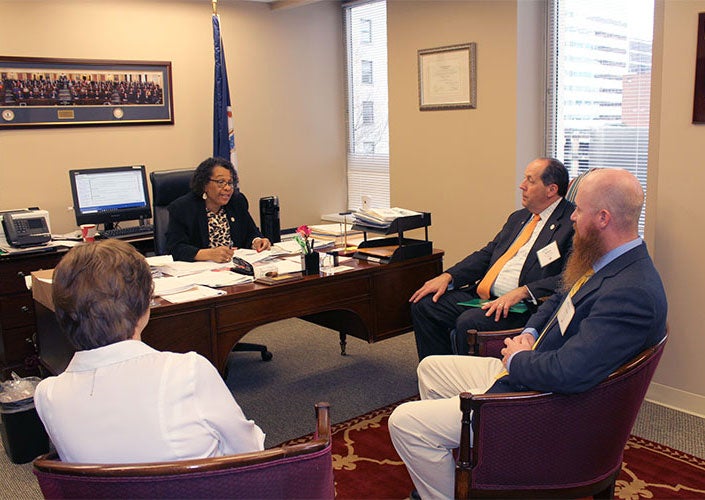Phone: (804) 346-3344
History & Role of the Association of Electric Cooperatives
The Virginia, Maryland & Delaware Association of Electric Cooperatives exists to serve the member-owned electric cooperatives in the three-state area. Founded in 1944 as the Virginia Association of Electric Cooperatives, the Association gained its present name when cooperatives from Maryland and Delaware were added. Thirteen co-ops in Virginia, one in Maryland, and one in Delaware are members of the Association. Association member cooperatives serve about 1.8 million people in the three states through over 650,000 meters in Virginia; more than 50,000 meters in Maryland; and over 95,000 meters in Delaware. More than 90 percent of these meters serve residences.
Electric cooperatives are consumer-owned, state-chartered electric utilities, and the Association is the largest consumer organization in each of the three states. Each of the Association’s member systems is represented by two directors on the Association’s board. Officers are elected each year for one-year terms following the annual membership meeting in July. The Board establishes policy and provides direction with quarterly board meetings held in January, April, July, and October. Board committees are used to provide planning and direction for the Association’s staff.
The Association and Old Dominion Electric Cooperative jointly own Regional Headquarters, Inc., which owns the Electric Cooperative Building outside Richmond that houses both organizations. The Association has 24 full-time positions to serve its members’ needs. The purpose of the Association is to provide services that can best be performed as a group effort on a state or regional basis. Activities generally fall into one of four departments, which are led by the Executive Department: Communications & Public Relations, Member & Public Affairs, Regulatory & Legal Affairs, and Safety Training and Educational Services.
The Association has proven to be of considerable value in providing coordination of activities concerning matters being considered at the national level by the Rural Utilities Service (RUS), the National Rural Electric Cooperative Association (NRECA), the National Rural Utilities Cooperative Finance Corporation (CFC), CoBank, Federated RE Insurance, and others. The Association’s role in providing key legislative, regulatory, safety, marketing, communications, and training support has increased substantially in recent years, as state and federal legislators and regulators have enacted sweeping measures affecting the electric utility industry and as our member-consumers have demanded more from us, collectively, when responding to storms and outages.
Cooperative Living magazine got its start on November 1, 1944, as a publication titled Rural Virginia published by Southside Electric Cooperative. In October 1946, Mecklenburg and Northern Piedmont (which merged in January 1980 with Virginia Electric to become Rappahannock Electric Cooperative) subscribed to Rural Virginia, and the publication was transferred to the state association. The magazine’s name was changed to Rural Living on August 1, 1970. Northern Virginia Electric Cooperative edition’s name was changed to Current Living on April 1, 1993. Then, in January 2000, both magazines were combined under one title, Cooperative Living. The magazine serves 13 of the 15 member cooperatives, with a combined circulation of more than 520,000. With a total readership of more than 1.4 million people, it is the most powerful communications vehicle published in Virginia. According to an independent survey, the magazine is read by more Virginians than Reader’s Digest, with more than 85 percent reading at least 3 of the last 4 issues. In addition to our publication covering Virginia and Maryland’s Eastern Shore, we publish Delaware Living once per year, circulating to nearly 100,000 Delaware Electric Cooperative member-consumers. Nationwide, there are 32 statewide magazines, which reach over 12 million readers in 42 states served by cooperatives. Combined, statewide magazines are one of the largest consumer-publication networks in the United States.
REA created
REA created
Farmers Rural Utility
Farmers Rural Utility is formed, VA's first non-profit utility.
Electric Cooperatives Act
General Assembly approves Electric Cooperatives Act.
Shenandoah Valley Electric Cooperative
Shenandoah Valley Electric Cooperative receives charter as VA's first electric co-op.
1st REA-financed Line
Farmers Rural Utility energizes first REA-financed line near Carmel Church, VA.
Southside Electric Cooperative
Southside Electric Cooperative energizes first line.
Four Co-ops Rise
Four co-ops begin operations: Shenandoah Valley, Delaware, Northern Neck, Mecklenburg; Southern MD, Farmers Rural Utilities, create VA Electric Cooperative.
Three More Co-ops
Three co-ops begin operations; BARC, Northern Piedmont, Choptank.
Two More Co-ops Rise
Two co-ops begin operations, Prince George Electric Cooperative and Community Electric Cooperative.
A&N

A&N begins operations.
NRECA founded

NRECA founded
VA Association of Electric Cooperatives
VA Association of Electric Cooperatives organized; Choptank and Delaware Electric Co-ops participate in Association meetings from the start.
Rural VA
Rural VA begins publication
A&N
ANEC merge with Chesapeake Islands Electric Cooperative.
Power Lines
Innovation run underwater from Eastern Shore to Smith and Tangier Islands.
Rappahannock

VA and Northern Piedmont Electric Co-ops merge to form Rappahannock Electric Cooperative.
A&N Grows
A&N acquires Delmarva Power's service territory in VA.
Allegheny Power
SVEC and REC acquire Allegheny Power's service territory in VA.

